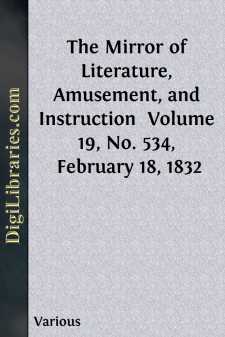Categories
- Antiques & Collectibles 13
- Architecture 36
- Art 48
- Bibles 22
- Biography & Autobiography 813
- Body, Mind & Spirit 142
- Business & Economics 28
- Children's Books 15
- Children's Fiction 12
- Computers 4
- Cooking 94
- Crafts & Hobbies 4
- Drama 346
- Education 46
- Family & Relationships 57
- Fiction 11828
- Games 19
- Gardening 17
- Health & Fitness 34
- History 1377
- House & Home 1
- Humor 147
- Juvenile Fiction 1873
- Juvenile Nonfiction 202
- Language Arts & Disciplines 88
- Law 16
- Literary Collections 686
- Literary Criticism 179
- Mathematics 13
- Medical 41
- Music 40
- Nature 179
- Non-Classifiable 1768
- Performing Arts 7
- Periodicals 1453
- Philosophy 64
- Photography 2
- Poetry 896
- Political Science 203
- Psychology 42
- Reference 154
- Religion 513
- Science 126
- Self-Help 84
- Social Science 81
- Sports & Recreation 34
- Study Aids 3
- Technology & Engineering 59
- Transportation 23
- Travel 463
- True Crime 29
The Mirror of Literature, Amusement, and Instruction Volume 19, No. 534, February 18, 1832
by: Various
Categories:
Description:
Excerpt
OUR LADY'S CHAPEL,
ST. SAVIOUR, SOUTHWARK.
The Engraving represents the interior of the Virgin Mary's Chapel, commonly called the Lady Chapel, and appended to the ancient collegiate church of St. Saviour, Southwark. The exterior view of the Chapel will be found in No. 456 of The Mirror. About eighteen months since part of the western side of the High-street was removed for the approach to the New London Bridge, when this Chapel was opened to view; but its dilapidated appearance was rather calculated to interest antiquarian than public curiosity. The London Bridge Committee recommended the parishioners of St. Saviour to cause the Chapel to be pulled down, and their selfish suggestion would have been complied with, had not some enlightened and public-spirited individuals stepped forth to frustrate the levellers. The parishioners now became two parties. One contended for the restoration of the Chapel, as "one of the most chaste and elegant specimens of early pointed architecture of the thirteenth century of which this country can boast." The levellers, whose muckworm minds, and love of the arts is only shown in that of money-getting—maintained that the demolition of the Chapel would be "a pecuniary saving;" but theirs was a penny-wise and pound-foolish spirit; for, by removing the Chapel, a greater expense would be incurred than in its restoration. The folks could not understand plain figures, and so resolved to take the sense and nonsense of the parish, and the subject has been decided by a majority of 240 in favour of repairing the Chapel. The funds for this purpose, it should be understood, were in course of provision by public subscription, so that the blindness of party zeal threatened to reject a special advantage—the public would find the money if they would allow the Chapel to remain—whereas, had the demolition taken place, the parishioners must themselves have defrayed the consequent expenses. Historians loudly condemn the royal and noble thieves who plundered the Coliseum and the Pantheon to build palaces, yet there are men in our times, who would, if they could, take Dr. Johnson's hint to pound St. Paul's Church into atoms, and with it macadamize their roads; or fetch it away by piecemeal to build bridges with its stones, and saw up its marble monuments into chimneypieces.
The church of St. Saviour is built in the form of a cathedral, with a nave, side aisles, transepts, a choir, with its side aisles; and the chapel of St. John, which now forms the vestry, and the chapel of the Virgin Mary, or Our Lady. To the east end of the latter there has since been added a small chapel, called the Bishop's Chapel. Another chapel, (of St. Mary Magdalen,) was also connected with the south aisle of the church. The parishioners seem to have hitherto neglected the Lady Chapel, and to have shown their cupidity in ages long past. Through the influence of Dr. Gardiner, Bishop of Winchester, they were allowed to purchase the church of that wholesale sin-salesman, Henry VIII.; but after the parish had obtained the grant of the church, they let the Lady Chapel to one Wyat, a baker, who converted it into a bake-house....












